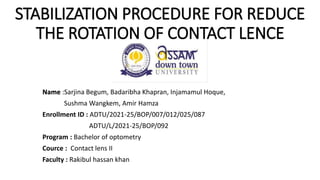
STABILIZATION PROCEDURE FOR REDUCE THE ROTATION OF CONTACT LENCE.pptx
- 1. STABILIZATION PROCEDURE FOR REDUCE THE ROTATION OF CONTACT LENCE Name :Sarjina Begum, Badaribha Khapran, Injamamul Hoque, Sushma Wangkem, Amir Hamza Enrollment ID : ADTU/2021-25/BOP/007/012/025/087 ADTU/L/2021-25/BOP/092 Program : Bachelor of optometry Cource : Contact lens II Faculty : Rakibul hassan khan
- 2. INTRODUCTION • More than 1/4 of all contact lens patients have astigmatism more than 1.25D. Stabilization technique is a very important procedure to stable the high toric contact lens on the toric cornea. Because in case of high astigmatism, there is a variation of contact lens thickness at different region of the contact lens and due to this reason there are chances of expelled of contact lens from the cornea. TORIC CONTACT LENS There are two types of toric contact lenses are used. • Soft toric contact lens - Most commonly used toric contact lenses • RGP toric contact lenses
- 3. Surface design of soft toric CL It is 3 types 1. Front surface toric 2. Back surface toric 3. Bi-toric
- 4. STABILIZATION • Better vision needs stable cylinder axis in proper place • Lid movement will attempt to move the lens in the same direction as itself. • Gravity and the inertia of lens and tear fluid, play relatively insignificant roles. There are 4 types of stabilization are used. 1. Prism ballast 2. Truncation 3.Double slabe off 4. Reference marking of CL
- 5. Prism ballast • A base down prism of between 1.00 to 1.50 D is ground at the lower part of the lens ,so that the lens will be heavier at the prism base. Gravity then acts to cause the • However , greater amounts of prism may be needed for patients with particularly tight lids, flat corneas , or oblique axis astigmatism . • The lens will tend to rotate so that the base of the prism is oriented inferiorly . • The added thickness of the lens along the prism base can reduce oxygen permeability through that portion of the lens resulting in possible hypoxic disturbance in the inferior zone of the cornea.prism base to locate inferiorly.
- 6. Truncation • Truncation refers to the techniques of cut off the bottom of the lens , so as to form a ‘shelf’ that will rest upon – and therefore align with – the lower lid. • This is a reasonably successful method of stabilizing lenses with thick edges, especially when combined with prism ballast. Either a single lower truncation , or a double truncation can be used. • The truncated section of the lens that is removed can be anywhere between a sag of 0.5 and 1.5 mm.
- 7. Double slab off • In this technique two thin zones are created superiorly and inferiorly. • These designs also rely on the interaction between lids and the lens to achieve stabilisation. • Both eyelids play an active role, unlike prism-ballast designs that involve interaction primarily from the upper lid. The design utilises thin zones; the lids squeeze against the thickness differential across the lens aligning the thicker central portion within the palpebral aperture and the thinner zones under the eyelids (figure 2a). • Refinement of this stabilisation approach has led to designs that isolate the optical correction within an optic zone resulting in independent stabilisation areas.
- 8. Reference marking • Soft toric lenses will usually have markings on the lens at a specific reference point so the degree of rotation can be assessed when the lens is on the eye. • Different manufacturers have different markings. • • They have may be usually permanent a laser or a temporary one with an ink or dye. • These markings indicate the lens orientation, helping both the wearer and the eye care professional to position the lens correctly. • • They are either a single or 3 marks with specific separation angle at the 6 o’ clock or horizontal (3 and 9 o’ clock) axis. • • One must refer to manufacturer’s guidelines before estimating rotation. Lens markings are for reference only.